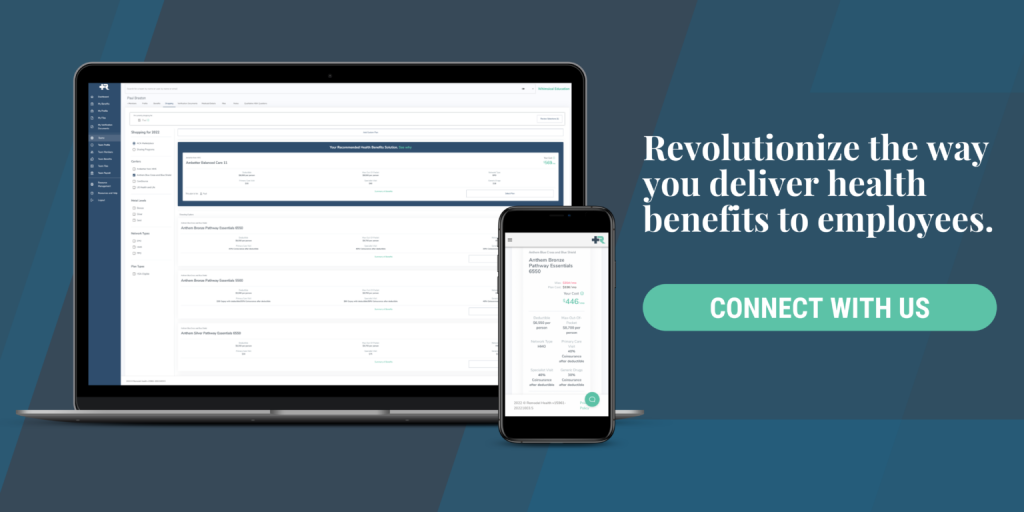Your Guide to ICHRA Rules
By Mallory Meyer on Aug 28, 2024 7:52:00 AM

When offering a benefits package, businesses today are often looking for ways to provide flexibility and control over health insurance options. One solution that has gained traction is the Individual Coverage Health Reimbursement Arrangement (ICHRA).
With so many terms and conditions, it’s essential for employers to understand the rules surrounding ICHRAs, ensuring both compliance and maximum benefit for their employees.
Understanding the rules that govern ICHRAs is important for businesses looking to tailor their employee health benefits packages effectively.
These regulations impact everything from eligibility criteria to what can be reimbursed. By having a solid grasp of ICHRA rules, businesses can offer employees greater choices in their health coverage, manage costs, and remain compliant with regulations.
What is ICHRA?
The Individual Coverage Health Reimbursement Arrangement (ICHRA) allows employers to reimburse their employees for the cost of individual health insurance premiums and other qualified medical expenses.
Instead of providing a traditional group health plan, employers can offer an ICHRA, giving employees the flexibility to choose their individual health insurance coverage. The goal is to provide a customizable option that fits diverse employee needs and preferences.
ICHRAs were introduced in 2020 as part of a broader shift towards flexible health coverage options. Before this, the Affordable Care Act (ACA) prohibited employers from reimbursing employees for individual market premiums. This began to change in 2017 with the introduction of Qualified Small Employer HRAs (QSEHRAs), allowing small employers some flexibility.
The introduction of ICHRAs marked a significant expansion, enabling businesses of all sizes to offer their employees more personalized health coverage options.
Key Components of ICHRA
Not all employees are eligible for an ICHRA. Eligibility depends on several factors, including the employee’s household income, employment status (full-time, part-time, or temporary), and whether they are covered under a collective bargaining agreement.
Employers can offer ICHRAs to specific classes of employees. However, under the ICHRA regulations, each employee within a class must be treated equally.
ICHRAs can reimburse a wide range of qualified medical expenses. These include the costs to diagnose, treat, and prevent disease and the equipment and supplies needed for those purposes. It’s essential for businesses to clearly define which expenses are covered and ensure compliance with ICHRA rules.
Allowable expenses also depend on whether employees have other health coverage, such as a spouse’s health plan or children’s health insurance program, and their eligibility for premium tax credits under the Affordable Care Act.
Setting Up an ICHRA
To set up an ICHRA, employers must meet certain requirements, such as clearly defining the employee classes eligible for the benefit and providing appropriate notice to eligible employees about their health insurance options.
Employees, on the other hand, need to purchase individual health insurance coverage that meets minimum essential coverage standards to qualify for reimbursement under the ICHRA.
Plan design is also crucial, as employers must decide on contribution amounts, reimbursement limits, and which expenses will be covered. This flexibility allows businesses to create a plan that fits their budget while offering valuable health benefits to their workforce.
Legal and Regulatory Framework
While the ACA plays a significant role in regulating ICHRAs, there are other key laws and regulations to consider, such as the Internal Revenue Code and the Health Insurance Portability and Accountability Act (HIPAA).
Employers must ensure their ICHRA plans comply with all relevant legal requirements, including providing minimum essential coverage and ensuring that the plans do not discriminate based on health status or other protected categories.
Compliance also involves proper documentation, record-keeping, and timely reporting to federal agencies to avoid penalties.
ICHRA vs. Other HRAs
Compared to QSEHRAs, ICHRAs are available to organizations of all sizes, providing greater flexibility in offering health benefits. Unlike QSEHRAs, which are limited to employers with fewer than 50 employees, ICHRAs can be offered to businesses regardless of their size.
When compared to traditional group health plans, ICHRAs allow employers to provide health benefits without the administrative burden of managing a group policy while also giving employees the freedom to choose their own coverage.
However, the flexibility of ICHRAs may come with complexity in plan design and administration, which businesses must carefully consider.
Tax Implications of ICHRA
ICHRA offers several tax benefits for both employers and employees. For employers, contributions made towards an ICHRA are generally tax-deductible as business expenses, helping to control overall costs.
Employees benefit as well, since reimbursements for individual health insurance premiums and qualified medical expenses are generally tax-free, provided they meet all requirements.
However, both employers and employees need to be aware of reporting requirements, such as filing appropriate forms with the IRS to ensure compliance and take full advantage of available tax benefits.
ICHRA Plan Design
Employers must consider reimbursement structure when designing an ICHRA plan. They must decide how much they will reimburse employees for qualified medical expenses and individual health insurance premiums, ensuring the amounts are consistent within each defined employee class.
Integration with the Health Insurance Marketplace is also crucial, as employees must purchase coverage that qualifies under ICHRA rules. Employers should provide clear guidance on navigating the marketplace and selecting appropriate plans that meet the minimum essential coverage requirements.
Employee Classes and ICHRA
Defining employee classes is critical to offering an ICHRA, as it allows employers to customize health benefits for different groups. These groups identified as “classes” include the following:
- Full-time and part-time employee status
- Salaried or non-salaried workers
- Geographic rating areas
- Seasonal or temporary staff
By tailoring Individual Coverage HRA benefits for each class, businesses can ensure they meet diverse employee needs while managing costs effectively.
However, they must comply with nondiscrimination rules, ensuring that all employees within a class receive the same reimbursement options and amounts, regardless of health status or other factors.
Funding and Budgeting for ICHRA
Determining the appropriate reimbursement amounts for an ICHRA involves evaluating the organization’s budget, employee demographics, and anticipated healthcare needs. Budgeting for ICHRA requires careful planning to control costs while providing meaningful health benefits to employees.
For instance, a company might decide to reimburse up to $300 per month for each full-time employee’s health insurance premiums while offering a lower amount for part-time workers.
By setting clear limits, employers can manage expenses while offering flexibility to employees in choosing their health plans.
Enrollment and Administration
The employee enrollment process for an ICHRA involves multiple steps, starting with informing eligible employees about their options and the requirements for purchasing individual health insurance coverage.
Employees typically need to renew their plans each year during the Open Enrollment Period, so employers should remind them of deadlines and any required proof of coverage renewal.
Ongoing administration involves regular communication, documentation, and efficient reimbursement processing, ensuring a smooth experience for both the employer and the employees throughout the year.
Employee Communication and Education
Effectively communicating the details of an ICHRA to employees is key to ensuring understanding and participation.
Employers should provide clear information on how the ICHRA works, eligibility requirements, and the steps employees must take to purchase individual health insurance coverage.
Educating employees on using the ICHRA includes offering guidance on selecting appropriate health plans, understanding eligible expenses, and the process for submitting reimbursement claims.
Providing accessible resources, such as FAQs, webinars, or dedicated support staff, can help employees navigate their options and maximize the ICHRA’s benefits.

ICHRA Compliance and Reporting
To stay compliant, employers offering an ICHRA must adhere to key requirements, including providing minimum essential coverage and ensuring fair treatment across all defined employee classes.
Reporting obligations include submitting necessary forms to the IRS and providing employees with statements regarding their health benefits.
Avoiding common pitfalls, such as failing to comply with nondiscrimination rules or missing reporting deadlines, is crucial to maintaining compliance and avoiding penalties. Employers should regularly review their ICHRA plans and procedures to ensure ongoing compliance with all relevant laws and regulations.
Integration with Health Insurance Marketplace
Integrating an ICHRA with the Health Insurance Marketplace allows employees to use their reimbursement funds to purchase individual health insurance plans that meet their specific needs.
The Health Insurance Marketplace, or the Exchange, is a service available in each state where individuals can compare, select, and enroll in health insurance plans that comply with the ACA standards.
Employees using an ICHRA must choose a plan that qualifies as minimum essential coverage to be eligible for reimbursements.
Employers should provide guidance on navigating the Marketplace, including tips for comparing plans, understanding costs like premiums and out-of-pocket expenses, and ensuring that the chosen plan meets ICHRA requirements.
Impact on Employee Benefits Strategy
Implementing an ICHRA can significantly enhance a company’s employee benefits strategy by offering a flexible, customizable health benefit option that meets diverse employee needs. It can also attract new talent and help retain top performers by demonstrating a commitment to providing valuable health coverage options.
Over the long term, ICHRA offers strategic advantages by enabling businesses to control costs, adapt to changing workforce demographics, and maintain compliance with evolving health insurance regulations.
Employers should consider how ICHRA fits into their broader goals and continuously evaluate its effectiveness in supporting their overall benefits strategy.
Unlock the Potential of ICHRA for Your Business
Offering an ICHRA is more than just a change in health benefits; it’s a strategic move that offers flexibility, cost control, and personalized options for your employees. By understanding ICHRA rules, setting up the plan correctly, and ensuring compliance, your business can provide valuable health coverage that meets diverse employee needs.
Integrating with the Health Insurance Marketplace further expands choices while effective communication and ongoing education keep everyone informed and engaged. So, elevate your benefits package today by leveraging the power of ICHRA to attract and retain top talent, control costs, and enhance your overall strategy.
Discover how Remodel Health can help you build an employee benefits package that truly works for your team.
Reach out to the Remodel Health team today to learn more.
Check out more resources
See these related articles

Who can use an ICHRA?
Learn who is eligible for ICHRA and how it works. Discover which employees can participate and what employers need to know about offering ICHRA.

The growing role of brokers as consultants with ICHRA
As ICHRA adoption grows, brokers are becoming trusted consultants for their clients. Explore how brokers guide clients through ICHRA strategy, setup, and compliance.

7 Common ICHRA Misconceptions Debunked
Discover the truth behind common ICHRA misconceptions to enhance your benefits understanding. Read the article for clear insights and practical tips.

